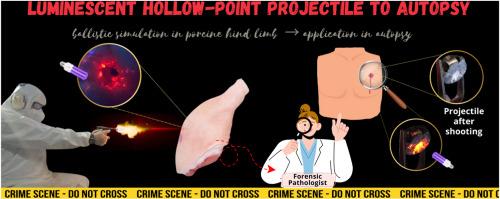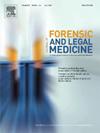Lanthanide luminescent markers in hollow-point projectiles to facilitate post-mortem ballistic analysis
IF 1.2
4区 医学
Q3 MEDICINE, LEGAL
引用次数: 0
Abstract
Hollow-point ammunition represents a substantial segment of the global arms market and is employed by law enforcement agencies in multiple countries. Its widespread adoption is primarily attributed to the greater extent of tissue damage it produces, combined with its reduced likelihood of over-penetration. Upon impacting the human body, the projectile deforms, often undergoing multiple deviations in its trajectory and, in some instances, fragmenting. These ballistic characteristics present significant challenges during autopsy procedures, frequently making it impossible to accurately reconstruct the projectile's path or recover it for subsequent ballistic comparison. In this study, we propose the incorporation of lanthanide-based luminescent markers into the cavities of .40 S&W hollow-point projectiles, which, upon deformation, gradually release these markers. Experimental tests were performed on various target media, including ballistic gelatin, ballistic clay, and fresh porcine hind limbs. In all cases, entrance wound, tissue disruption, and projectile trajectories were clearly visualized using a standard forensic light source. Furthermore, a forensic scenario was simulated involving a victim inside a vehicle. In this scenario, the projectile penetrated the car door and deformed only upon striking the victim's body, thereby releasing the marker. The developed markers do not alter the ballistic performance of the ammunition, are chemically inert, and remain stable under conditions of high temperature and pressure. They can be readily recovered from biological matrices and subsequently analyzed via infrared vibrational spectroscopy. The results of the tests indicate a significant potential for facilitating faster and more accurate autopsy examinations.

空心弹丸中的镧系发光标记物,以促进死后弹道分析
空心弹在全球武器市场中占有相当大的份额,被多个国家的执法机构使用。它的广泛采用主要是由于它产生更大程度的组织损伤,加上它降低了过度渗透的可能性。在撞击人体后,弹丸会变形,通常在其轨迹上经历多次偏差,在某些情况下,会碎裂。这些弹道特征在尸检过程中提出了重大挑战,经常使其不可能准确地重建弹丸的路径或恢复其随后的弹道比较。在这项研究中,我们提出将基于镧系元素的发光标记物结合到。W空心点弹丸,变形后逐渐释放这些标记物。实验在各种靶介质上进行,包括弹道明胶、弹道粘土和新鲜猪后肢。在所有案例中,使用标准的法医光源,可以清楚地看到入口伤口、组织破坏和弹丸轨迹。此外,还模拟了一个涉及受害人在车内的法医场景。在这种情况下,弹丸穿过车门,只有在击中受害者身体时才变形,从而释放了标记物。开发的标记物不改变弹药的弹道性能,是化学惰性的,并且在高温和高压条件下保持稳定。它们可以很容易地从生物基质中回收,随后通过红外振动光谱分析。测试结果表明,在促进更快和更准确的尸检检查方面具有巨大潜力。
本文章由计算机程序翻译,如有差异,请以英文原文为准。
求助全文
约1分钟内获得全文
求助全文
来源期刊

Journal of forensic and legal medicine
MEDICINE, LEGAL-
CiteScore
2.70
自引率
6.70%
发文量
106
审稿时长
57 days
期刊介绍:
The Journal of Forensic and Legal Medicine publishes topical articles on aspects of forensic and legal medicine. Specifically the Journal supports research that explores the medical principles of care and forensic assessment of individuals, whether adult or child, in contact with the judicial system. It is a fully peer-review hybrid journal with a broad international perspective.
The Journal accepts submissions of original research, review articles, and pertinent case studies, editorials, and commentaries in relevant areas of Forensic and Legal Medicine, Context of Practice, and Education and Training.
The Journal adheres to strict publication ethical guidelines, and actively supports a culture of inclusive and representative publication.
 求助内容:
求助内容: 应助结果提醒方式:
应助结果提醒方式:


